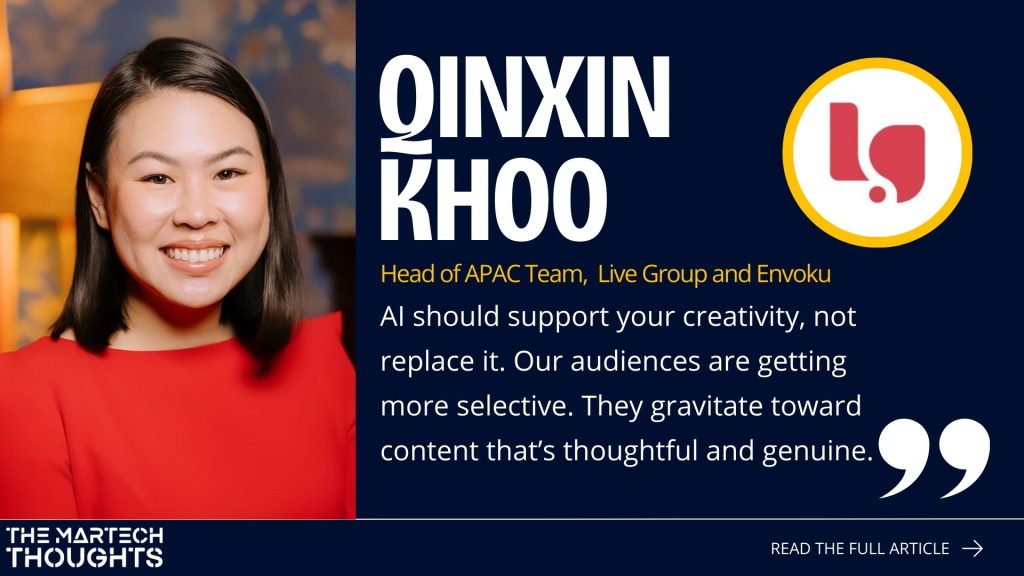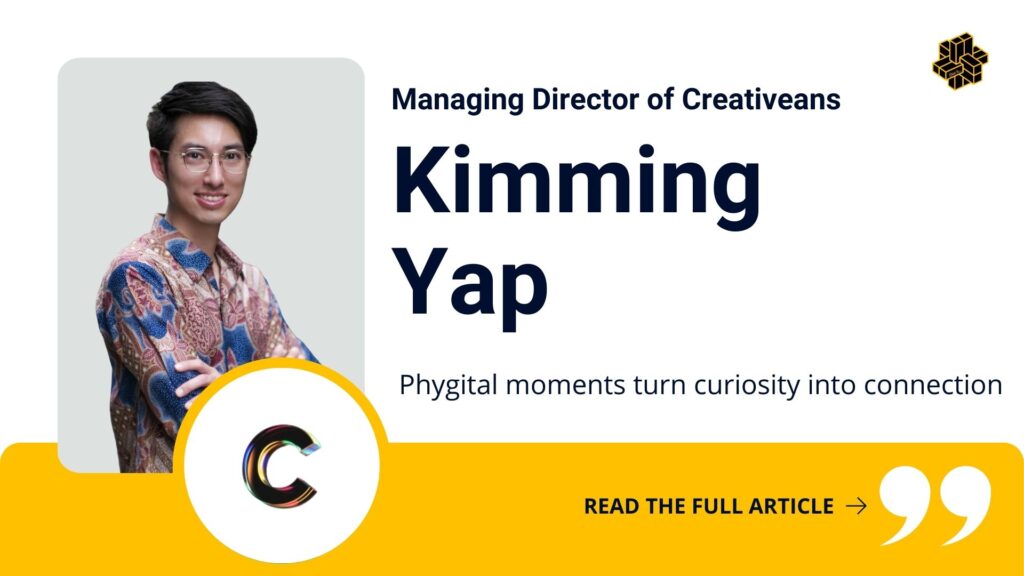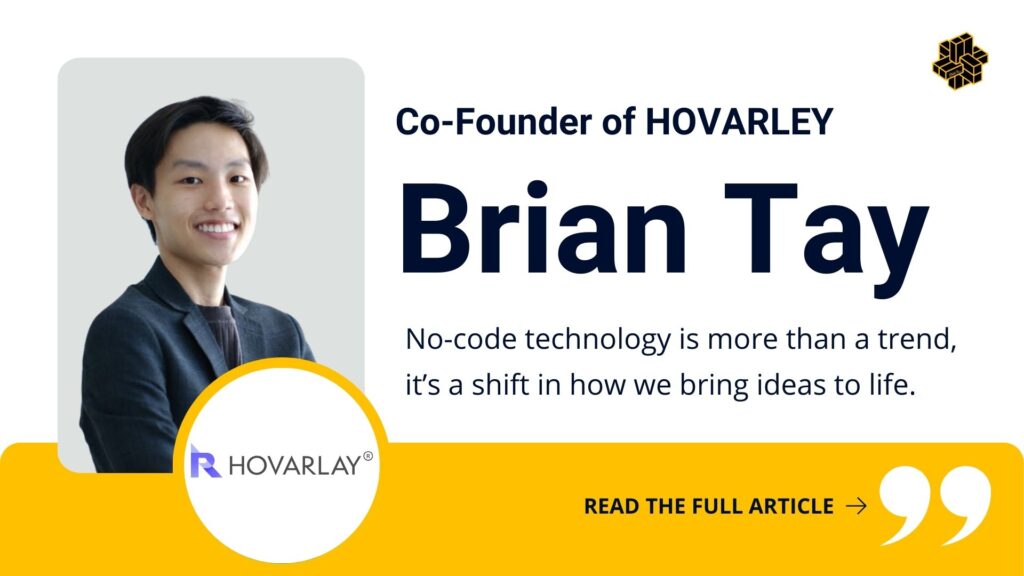
MarTech Perspectives with Qinxin Khoo: Designing Hyper-Personalised Experiences That Resonate
Qinxin Khoo leads the APAC team at Live Group and Envoku from their regional headquarters in Singapore. With a strong focus on experience design and audience-centric strategy, she works daily across cultures, personalities, and platforms to deliver compelling engagement. In this Q&A, Qinxin explores the evolving meaning of hyper-personalisation, the expectations of new digital-native audiences, and the balance between AI-driven efficiency and human authenticity.
More About Qinxin
Q: Please introduce yourself and tell us a bit about your role at Live Group and Envoku.
I lead the APAC team at Live Group and Envoku out of our Singapore HQ. In my role, I have 2 sets of audiences that I interface with daily. First, my team is made up of vastly different personalities and talents. The second would be the clients we partner with to deliver events, and in turn, take care of their audience for them. In a nutshell, I can communicate to a dozen different audiences in different ways every day!
Redefining Hyper-Personalisation
Q: In your view, how do we define hyper-personalisation today, and how has that definition evolved?
Hyper-personalisation is something most of us can feel, even if we’re not always fully aware when it’s happening. Early versions were quite straightforward: you’d see your name pop up in a cold email or get a few personalised product recommendations on Amazon. Now, it’s much more fluid. Platforms use real-time behavioural and emotional insights- think Spotify suggesting music based on your mood, or ChatGPT adapting its tone and style to match how you communicate.
While hyper-personalisation has largely been a digital experience up to now, we’re starting to see it carry over and scale into in-person environments. Events, offices, even internal comms are now being designed to flex around the individual. That’s a huge shift from mass engagement to meaningful, one-to-one connection at scale.
Understanding the New ‘Experience Natives’
Q: How is hyper-personalisation shaping the expectations of today’s ‘experience natives’?
For Gen Z and Gen Alpha entering the workforce for the first time, hyper-personalisation is a norm, not a novelty. If organisations want to connect with their incoming audiences, and they should, they need to find ways to adapt quickly.
It’s not just simply tailoring your language to what you think a younger audience will be interested in. They should not be seen as just one single group of audience; they are as individually, psychologically, and culturally diverse as any other generation. It is key to understand that they have grown up in an environment where communication is inherently personalised. The expectation is for communication to be relevant and intuitive.
What really matters here for organisations is building systems that help you understand and reach your people as individuals. That’s what drives engagement and loyalty, and it’s what sets forward-thinking brands apart. The choice is to do that or get left behind.
Balancing AI Efficiency with Human Authenticity
Q: Digital-native audiences know much content is AI-powered – how can brands still make it feel human and authentic?
People can tell when something’s been auto-generated. AI content might be fast, but it often lacks depth. Brands that will succeed are the ones that pair automation with intention. AI should support your creativity, not replace it. Our audiences are getting more selective. They gravitate toward content that’s thoughtful and genuine. That human touch—your voice, your judgment, your story—is what cuts through the noise.
Q: What role does data play in enabling hyper-personalisation, and how can it be used responsibly?
Data insights are integral to enabling hyper-personalisation. It’s true that without them, there’s no way to tailor experiences at an individual level. These programmes might pull from anything, whether it’s analysing past and current behaviour to predict what audiences may want or need next, or using more intelligent micro-segmentation based on characteristics like mood or intent. Of course, when using such deep insights about a person’s behaviour, the important thing is ethical data handling.
At Live Group and Envoku, we use our own AudienceDNA profiling tool, which acts only with the informed consent of the audience and offers an easy opt-out. The choice should always sit with the audience, and opting out will never limit someone’s ability to participate fully.
We should also be focused on giving back. When audiences choose to share their information to help us shape better experiences, it should always be used to create something better in return, and their trust should never be taken for granted. We believe privacy isn’t a trade-off; it’s part of the value exchange.
Hyper-Personalisation in Action
Q: What are some of the most successful use cases you’ve seen where hyper-personalisation made a measurable impact on engagement or loyalty?
It’s no secret that hyper-personalisation is now a core expectation for most audiences, and 70% say they feel frustrated when it isn’t delivered. Netflix itself has reported that 80% of its content is discovered through personalised recommendations, which are made even more effective by changing the artwork and interface based on each user’s behaviour.
Q: What are the biggest challenges when scaling hyper-personalised strategies across diverse customer and employee groups?
One of the hardest parts is just knowing where to begin. Truly meaningful personalisation needs deep insights—and when you’re dealing with multiple segments across regions, that can feel overwhelming. But it’s not just a tech issue; it’s a strategic one. You need systems that adapt in real time, and a team that knows how to manage them. Success depends on getting the right balance of tech, trust, and talent.
Looking Ahead: The Future of Experience Design
Q: What are the biggest challenges when scaling hyper-personalised strategies across diverse customer and employee groups?
I’m most excited to see how this develops in the events space. The fact that we can already personalise in-person experiences at scale is a huge step forward in making events more engaging and effective than ever. With the integration of technologies like biometric sensors and ambient systems, events are becoming responsive environments that adapt to attendees’ needs in real time. These systems can detect everything from engagement levels to stress indicators, and automatically adjust elements like lighting, sound and temperature to create an optimised experience for each participant.
However, I think a regularly missed opportunity lies in what happens before the event or communication campaign even begins. There’s so much valuable data that can be collected pre-event (think communication preferences, interests, goals), and those insights can inform everything from programming to space design to communication cadence. Instead of waiting to react onsite or post-communication (for the next time you do the outreach again), we can proactively shape an experience that’s already better aligned with what people want and need. When we plan with the audience in mind from the start, the event becomes less about adapting for the next time around and more about getting it right the first time. That’s where real personalisation begins.
A big thank you to Qinxin Khoo, Head of APAC team at Live Group and Envoku. Qinxin’s approach to hyper-personalisation is thoughtful, strategic, and human-centric. Her vision goes far beyond AI gimmicks or segmented targeting – it’s about building real connection, rooted in trust and insight. For brands that want to stay relevant in a world shaped by ‘experience natives’, Qinxin’s advice is clear: “Design with intention. Personalise with empathy. And never forget – every audience is made up of individuals.” If you want to connect with him, feel free to reach out via LinkedIn!
See more MarTech Thoughts interview pieces here!
Stay up to date with our In Person Summit, Session Information, and Agenda Updates by following us on:
Last updated: May 2025













